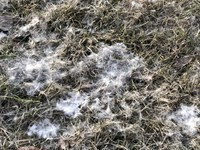Dakota Gardener: Snow Mold Is Affecting Lawns this Spring
(Click an image below to view a high-resolution image that can be downloaded)
By Esther E. McGinnis, Horticulturist
NDSU Extension
A week ago, I came home to an unusual scene in my yard. As the sun was setting, I observed a fluffy substance resembling spider webs stretching across portions of the lawn. Were we invaded by a million spiders? Before you get the heebie jeebies, I can reassure you that I had not entered an arachnid horror movie.
This white, cottony substance occurred in areas of the lawn that had been covered with snow for the entire winter. The spring melt revealed the gray snow mold that had flourished under the protection of the moist snow at near-freezing temperatures.
Gray snow mold is a common fungal disease that affects turfgrass and is worst in years with early and persistent snow. The white substance mentioned above is a sign of the actual fungus and disappears quite quickly. More noticeable disease symptoms include circular patches of straw-colored, matted turfgrass.
No cure exists once snow mold has affected the lawn. Damage mitigation consists of lightly raking the matted turfgrass to allow more air circulation. Raking should be delayed if the lawn is still muddy.
Snow mold rarely kills turfgrass crowns. If it does kill patches, reseeding can quickly fill in the area.
The best time to prevent snow mold is in fall. The final mowing in fall should be at the height of two inches. Tall grass is more likely to be matted down and infected by snow mold.
If snow mold has been a persistent problem in your yard, examine your fall fertilizer practices. Late applications of lawn fertilizer make the turfgrass more susceptible to disease. The final fertilizer application of the year should take place around Labor Day or early September.
Homeowners frequently ask about applying fungicide to the lawn in fall. North Dakota State University Extension does not recommend the application of fungicide to home lawns to prevent snow mold for a number of reasons.
The most effective turf fungicides are not legal to apply to residential lawns and the optimal timing for making fall applications is still being researched.
Turfgrass selection can impact susceptibility to snow mold. Kentucky bluegrass, perennial ryegrass, and tall fescue are quite susceptible. In contrast, fine fescue blends that contain hard fescue tend to be more resistant to injury.
One final note about snow mold—it can indeed cause allergies in individuals. I have been miserable for a week now. However, I risked aggravating my symptoms to take the photo that accompanies this article. The things we do for our jobs!
Happy spring!
NDSU Agriculture Communication - March 29, 2022
Source: Esther McGinnis, 701-231-7971, esther.mcginnis@ndsu.edu
Editor: Kelli Anderson, 701-231-6136, kelli.c.anderson@ndsu.edu




